
Robotics and Textile Composites Group
The Robotics and Textile Composites Group brings together inter-disciplinary activities in applied robotics, textile mechanics and composites manufacturing technologies. The group creates next generation lightweight materials and structures for aerospace, automotive, marine, oil and gas, industrial and medical applications.
Since 2000, the group has been working in close collaboration with the High Value Manufacturing Sector, through collaborative research and development programmes. The group plays a key role in developing manufacturing science of multi-architecture, multi-functional 3D fibre preforming at the EPSRC Centre for Innovative Manufacturing in Composites (HUB).
Currently the group is actively researching the incorporation of smart and nano-scale materials into 3D fibre architectures for sensing actuation and power storage.
The group comprises over 25 members, including academics, postdocs, experimental officers, PhD and MPhil students.
This is one of the largest manufacturing groups in the world working at the interface of robotics, textile preforming and composites.
Group specialisms
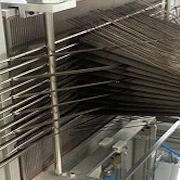
3D weaving
A conventional Jacquard weaving machine is adapted to manufacture 3D weaving preforms with variety of weave architectures and complex 3D geometries such as T and Pi sections and preforms with multiple pockets and openings. The loom is also equipped with warp and weft tension control. This machine is capable of inserting up to 22 picks simultaneously into multiple sheds in order to achieve thick preforms.
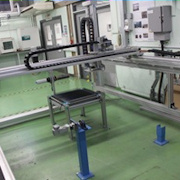
Robotic fibre placement and tufting
3D weaving is ideally suited for producing continuous lengths of multi-layer preforms, but requires long setup time as well as relatively large inventory of fibres. A low-cost robotic dry placement process has been developed as part of current research, in which relatively complex and thick preforms can be produced with the aid of a tow deposition head attached to a Cartesian robot. Once the tows are deposited, through thickness tows are inserted using a tufting head attached to the robot.
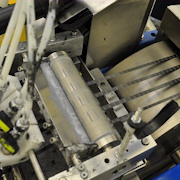
Multifunctional material
Multi-functional composites are finding applications in thermal management, radiation shielding, stealth, structural health monitoring and energy storage, to name a few. A novel screen printing technique has been developed in order to print grid lines on a spread carbon fibre tape; a viscous print paste consisting of micro-scale metallic powders in an epoxy compatible sizing has also been developed.
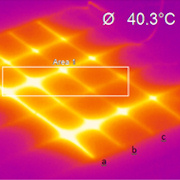
Thermal fabric
Embedding Electro-Thermal Yarns in Textiles for Surface Heat Generation. Thermal yarns can be woven along with high performance fibres in 3D weave architectures. In a multi-layer woven fabric yarn can be introduced into top, middle or bottom layer as required.
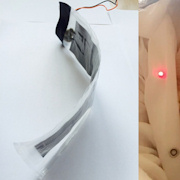
Flexible thin battery and solar cell
A flexible thin battery has been developed by the group for use with textile garments as well as composites. This lithium ion battery is 1.5mm thick, and can be used for energy storage. This battery has the novel approach of using Nano materials.

Medical textiles
Braiding technology is also used for various biomedical applications such as sutures, stent as a scaffold inside arteries and vessels, braided bone setting device, dental floss, artificial cartilage, composites prosthetic intervertebral disc, and so on. Some of these applications use fine denier monofilaments for braiding purpose. As part of the group’s research, braiding and weaving technology can be used for research of medical textiles.
Case study: Braiding, complex winding and braid-winding
Braiding has the potential to produce near-net preforms at a reasonable cost. Braiding is the process of diagonally interlacing three or more strands of yarn in order to create continuous rope-, tube-, or ribbon-like structures. Traditionally developed for manufacturing textile products such as shoe laces, candle wicks, trims, and cordage, the braiding process has been widely used in manufacturing flexible engineering products such as hydraulic hoses. However, braiding technology has been popularized by the space technologies in the 1970s and more recently by the insertion of carbon composites in civil airframes[1]. Since it produces a seamless structure, it has become a popular technology for producing cylindrical composite structures.

A complex 9-axis winding is a type of filament winding method developed in The University of Manchester. Although filament winding is a widely used and commercially available technology, filament-wound structures behave like unidirectional laminates. In addition, filament winding a mandrel with complex bends is a considerable challenge; it is more convenient to braid a mandrel with complex bends since mandrel does not rotate during the braiding process. In order to overcome the problem of winding complex geometries with conventional filament winding, a novel 9-axis winding machine was developed by the RTC in 2010. In this concept, the complex shape mandrel is manipulated robotically to cope with complex bends while multiple sets of bobbins rotate around it to place the fibres. The bobbins are mounted on rotating wheels and the wheels also have the freedom of movement in one of their perpendicular planes. The equipment produces a non-interlaced preform as the conventional filament winding technology.
Braid-winding is an inline braiding and filament winding method for developing cylindrical composite preforms. Together braiding and winding layup can produce a quadriaxial layup that can improve certain cylindrical composite properties. A winding unit is under construction to be in line with one of the braiding equipment that will allow development of simultaneous production of quadriaxial quasi-isotropic cylindrical preforms.
Since over-braiding has become a popular preforming technique for developing composite structures, RTCG is focusing on substantial research work on this method. The manufacturing facilities of the group include two maypole braiding machines (24 and 48 carriers), one radial braiding (48 carriers) and one profile braiding (4x4) machines. The group activities on braiding involve developing tubular as well as complex composite structures for various commercial applications. Alongside, the group researches in fundamentals of braiding process and structures.
As part of the group’s interest in developing new technologies, an Orthogonal braiding machine was developed in recent years. Also, the group is currently working on incorporation of sensors in composite pipes and shafts.
[1] P. Potluri, "Braiding," in International Encyclopedia of Composites vol. 1, L. Nicolais, A. Borzacchiello, and S. M. Lee, Eds., ed. New York: Wiley, June 2012.
